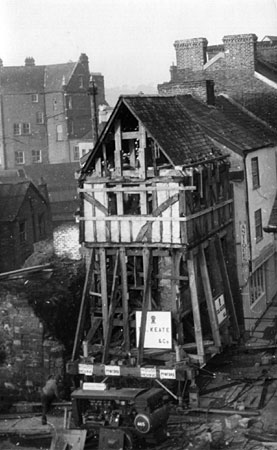Structure relocation
Relocation is the process of moving a structure from one place to another. This can be done either by disassembling the structure and reassembling it in a new position, or by transporting it in its entirety.
There are a number of reasons why a structure may need to be moved. There could be commercial reasons, it may be necessary to free up the plot of land that it stands on, it may be sold to a new owner and so on. It is also an increasingly common method of preserving important or historic buildings that may be threatened by flooding, redevelopment, adverse ground conditions, and so on.
If the method selected is to move the structure in one piece, then very careful planning and coordination is required. Typically, the process begins with openings being cut in the building’s foundation. This allows the installation of a temporary framework attached underneath for structural support.
Hydraulic jacks are installed under the framework that are connected to a central control system. This system monitors the pressure on each jack and helps to keep the building level as it is lifted up off the foundation. The structure may be elevated in increments using cribs (large timber beams) that are stacked into piles as a means of supporting the hydraulic jacks that are re-positioned gradually higher on them. Once raised to a sufficient height, the building is ready to be transported.
If the distance is relatively short, temporary rails or hydraulic dollies can be placed under the framework to enable it to move. If the distance is greater, flatbed trucks are used. In this case, projections such as chimneys may need to be removed and the journey planned to allow for obstacles en route such as trees and overhead cables. Once the move is complete, the structure is lowered onto a newly prepared foundation by reversing the above steps.
Some modern modular buildings may be designed to be re-locatable. This may be possible without disassembly, or may require some separation of parts. Site huts on construction sites are an example of modular buildings that can be taken apart, moved, and reconfigured for another use. Increasingly other construction buildings are also re-locatable, such as pre-fabrication and manufacturing facilities. See flying factory for more information.
Disassembling buildings that were not designed for relocation is a complex process that requires careful planning and meticulous record keeping. This is only likely to be necessary for buildings that are important or protected, such as historically significant buildings.
Some structures are intended to be disassembled and relocated, such as live events structures which may tour from one location to another. In this case, the components are designed to be dismantled, transported and re-assembled.
Increasingly, permanent buildings are also being ‘designed for deconstruction’, that is they are constructed in a way that will make it easier to take them apart and use the components again, either at the end of their life, or for relocation.
See Design for deconstruction for more information.
Some famous examples of relocated buildings include:
- ‘The house that moved’, Exeter: In 1961, an entire 16th century Tudor house was moved on rollers to make way for a new inner by-pass (see image).
- St. Fagan’s National History Museum, Cardiff: An open-air museum consisting of more than 40 re-erected buildings from various locations in Wales.
- London Bridge: In 1968, the bridge was sold to an American entrepreneur who had it transported to Lake Havasu City, Arizona, where it was reassembled. Famous rumour has it that he mistakenly believed he was buying Tower Bridge.
[edit] Related articles on Designing Buildings Wiki:
- Building an extension.
- Conservation of the historic environment.
- Demolition.
- Design for deconstruction, BRE modular show house.
- Design for deconstruction, ski slope.
- Design for deconstruction.
- Dismantling.
- Flying factory.
- Future proofing construction.
- Halley VI Research Station.
- Historic environment.
- John Rennie.
- Kit house.
- KODA house.
- Live events.
- Location.
- Modular buildings.
- Move management.
- Off-site prefabrication of buildings: A guide to connection choices.
- Prefabrication.
- Regeneration.
- Renovate, operate, transfer (ROT).
- Temporary building
- Temporary works for construction.
[edit] External references
- Mammoth movers - Historical structures
- Everything Explained - Structure relocation
IHBC NewsBlog
Old Sarum fire in listed (& disputed) WW1 Hangar - Wiltshire Council has sought legal advice after fire engulfed a listed First World War hangar that was embroiled in a lengthy planning dispute.
UK Antarctic Heritage Trust launches ‘Virtual Visit’ website area
The Trust calls on people to 'Immerse yourself in our heritage – Making Antarctica Accessible'
Southend Council pledge to force Kursaal owners to maintain building
The Council has pledged to use ‘every tool in the toolbox’ if urgent repairs are not carried out.
HE’s Research Magazine publishes a major study of the heritage of England’s suburbs
The article traces the long evolution of an internal programme to research 200 years of suburban growth
IHBC Context 183 Wellbeing and Heritage published
The issue explores issues at the intersection of heritage and wellbeing.
SAVE celebrates 50 years of campaigning 1975-2025
SAVE Britain’s Heritage has announced events across the country to celebrate bringing new life to remarkable buildings.
IHBC Annual School 2025 - Shrewsbury 12-14 June
Themed Heritage in Context – Value: Plan: Change, join in-person or online.
200th Anniversary Celebration of the Modern Railway Planned
The Stockton & Darlington Railway opened on September 27, 1825.
Competence Framework Launched for Sustainability in the Built Environment
The Construction Industry Council (CIC) and the Edge have jointly published the framework.
Historic England Launches Wellbeing Strategy for Heritage
Whether through visiting, volunteering, learning or creative practice, engaging with heritage can strengthen confidence, resilience, hope and social connections.














